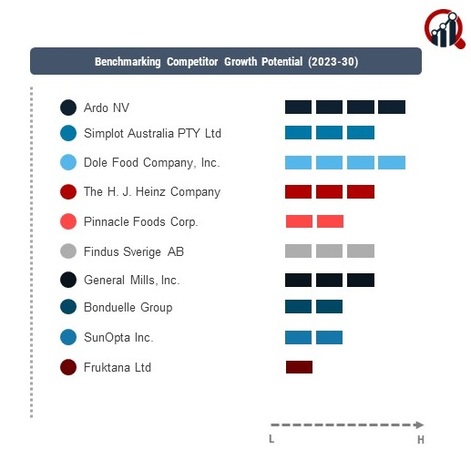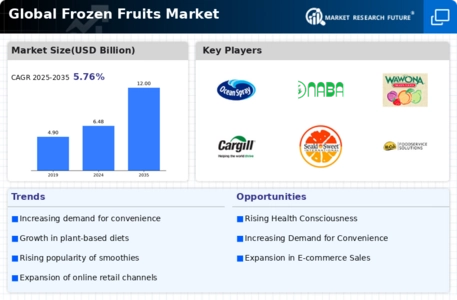Top Industry Leaders in the Frozen Fruits Market
The Competitive Landscape of the Frozen Fruit Market in 2023 is shaped by key players implementing various strategies to cater to the increasing consumer demand for convenient and nutritious frozen fruit options. Established companies and emerging players alike navigate this competitive environment through tactics such as innovation, efficient supply chain management, and strategic partnerships to address the evolving needs of consumers.
Key Players:
Ardo NV of Belgium region
Rasanco Ltd of the United Kingdom
Simplot Australia Pty Ltd of Austria region AXUS International LLC of the United States
Dole Food Company Ltd of the United States
Alasko Foods Inc. of Canada
the HJ Heinz Company of the United States
Breukers Scamp Food of Netherlands
Pinnacle Food Corporation of the United States
Capricorn food products India Ltd of India
Findus Sverige Ab of Sweden
Frucktana Ltd of North Barcelona
General Mills Inc. of the United States
SunOpta inc. of Canada
Bonduelle Group of France and many more.
Strategies Adopted:
Key players in the Frozen Fruit Market deploy a variety of strategies to maintain and enhance their market positions. Continuous innovation in product offerings and packaging is a central focus, with companies aiming to meet consumer demands for diverse and convenient frozen fruit options. Strategic alliances with retailers, foodservice providers, and distributors are common, enabling players to expand their market reach and optimize distribution networks. Some companies also invest in sustainable sourcing practices and environmentally friendly packaging solutions to align with the increasing consumer preference for eco-friendly products.
Market Share Analysis:
Several factors contribute to the analysis of market share in the Frozen Fruit Market. The reputation for product quality and consistency is crucial, with consumers gravitating towards brands with a track record of delivering reliable frozen fruit products. Pricing strategies that balance competitiveness with profit margins play a vital role, especially in a market where price-conscious consumers seek value for money. Robust and efficient supply chain management is essential to ensure timely delivery and maintain a competitive edge in a market that values product availability.
New and Emerging Companies:
While established companies dominate the Frozen Fruit Market, new and emerging players are making strides with a focus on innovation or specialization in specific frozen fruit varieties. These entrants often bring fresh perspectives to the market, emphasizing unique blends, organic offerings, or novel freezing technologies. Their agility allows them to quickly adapt to changing consumer preferences and explore niche markets, challenging the market share of more established players.
Industry Trends:
The Frozen Fruit Market has witnessed significant industry news and investment trends in 2023. Key players are investing in advanced freezing technologies to preserve the nutritional content and taste of frozen fruits. Investments in research and development are prevalent to explore new product formulations and improve the overall quality of frozen fruit offerings. Companies are also embracing digitalization and data analytics to optimize supply chain processes and enhance overall business efficiency.
Competitive Scenario:
The overall competitive scenario in the Frozen Fruit Market is marked by a dynamic interplay between established players and emerging entrants. Industry competitiveness is evident in the constant pursuit of new product development, market expansion, and the optimization of operational processes. Companies that successfully balance innovation, sustainability, and cost-effectiveness contribute to the dynamic nature of the sector.
Recent Development:
The Frozen Fruit Market. Dole Food Company, Inc. announced a strategic partnership with a leading retail chain to launch a line of exclusive frozen fruit blends, showcasing the importance of collaborations in reaching specific consumer segments. Ardo Group invested in upgrading its frozen fruit processing facilities to enhance efficiency and meet the increasing demand for a broader range of frozen fruit products. These developments underscore the industry's commitment to innovation, strategic partnerships, and meeting the diverse demands of the global Frozen Fruit Market.










